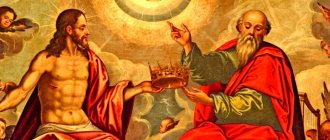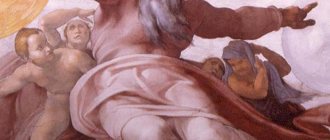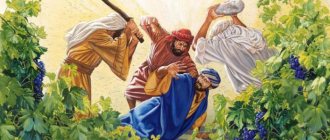Conversation with the Samaritan woman
Conversation between Christ and the Samaritan woman. Kareya Monastery, Athos, XIII century.
Jesus remained with His disciples in Judea for some time. Many then wanted to listen to His preaching and become His disciples. But when Jesus learned that this was beginning to cause unrest among the Jewish Pharisees, He decided to leave Judea and return to Galilee, where He spent His childhood and youth. The direct route from Judea to Galilee lay through Samaria, an area inhabited by the descendants of mixed marriages between Israelites and pagans. The Samaritans recognized the Pentateuch of Moses as Holy Scripture, but their religion also contained elements of paganism. The main point of dispute between the Samaritans and the Jews was the question of where to worship God: the Jews, since the time of David, had sacrificed in Jerusalem, and the Samaritans erected an altar on Mount Gerizim. There was enmity between the Samaritans and the Jews, so that the very word Samaritan was considered abusive and contemptuous by the Jews.
At noon, the Lord and the disciples stopped at a well near the Samaritan village of Sychar. The heat made it difficult to continue the journey, and the disciples, leaving the Teacher at the well, went to the village to buy food. At this time, a Samaritan woman came to the well. Jesus said to her, “Give me something to drink.” Seeing from his clothes and speech that this was a Jew in front of her, she was surprised: “How can you, being a Jew, ask me, a Samaritan woman, for a drink?” Jesus answered her: “If you knew the gift of God and Who speaks to you, then you yourself would ask Him, and He would give you living water.” The woman did not understand the spiritual meaning of Jesus’ words and objected: “You have nothing to draw with, and the well is deep. Where did You get your living water from?” Jesus answered her, “Whoever drinks of this water will want to drink again, and whoever drinks of the water that I give him will never thirst; the water will become for him a fountain flowing into eternal life.” Jesus spoke about the gift of the Holy Spirit, but the woman again did not understand Him: “Then give me such water that I will no longer want to drink and I will not need to come here for water.” Jesus said to her: “Go, call your husband,” to which the Samaritan woman replied that she did not have a husband. The Lord did not need to know about a person from stories, He saw through every person and therefore said: “You are right when you say that you do not have a husband. After all, you had five husbands, and the one with whom you live now is not your husband.” The woman was surprised at Him: “Sir! I see that You are a prophet. Then tell me where God should be worshiped—on Mount Gerizim, as our fathers say, or in the Temple of Jerusalem, as the Jews teach?” Jesus answered her: “Believe Me, the time will come, and has already come, when true worshipers will worship God in spirit and truth wherever they are.”
Fresco Life-Giving Spring
In the Pentateuch, Moses spoke of Christ as a great prophet and teacher of the people, so the Samaritan woman asked Jesus: “I know that the Messiah must come, that is, Christ; when He comes, He will tell us everything.” And then Jesus revealed to her a great secret: “It is I who speak to you.” At this time, His disciples returned with food, and the woman, abandoning the waterpot, ran to the village to tell all the people about her amazing meeting. Meanwhile, the disciples offered food to the Lord, to which He said to them: “My food is to do the will of Him who sent Me and to complete His work. Lift up your eyes and look at the fields, how they are white and ripe for harvest.” The Lord stayed in this Samaritan village for two days, and during this time many Samaritans from Sychar willingly listened to Him and believed in Him. After this, Jesus and the disciples continued on their way to Galilee.
Having come to the city of Cana, where He once turned water into wine, Jesus performed His second miracle in Galilee. He was approached by a courtier whose sick son was dying in Capernaum. Hearing about what Jesus was doing in Judea, he asked Him to come and heal the boy. “Go, your son is well,” Jesus said. Believing this, the courtier hurried home and learned that the child’s illness had left him at the very moment when he was talking to Jesus.
Who is the Samaritan woman and why does she have her own week in Orthodoxy?
In the 5th week after Easter, the Church remembers the conversation of Jesus Christ with the Samaritan woman (this week is also called the Week of the Samaritan). In her person, the Church presents to us the image of a sinner seeking salvation and ready to hear the calling voice of the Savior.
Returning from Judea to Galilee, Jesus Christ and His disciples passed through the Samaritan country. The Assyrian king Shalmaneser conquered the Israelites and took them into captivity, and in their place he settled pagans from Babylon and other places. From the mixing of these settlers with the remaining Jews, the Samaritans arose. The Samaritans accepted the Pentateuch of Moses, worshiped Jehovah, but did not forget their gods. When the Jews returned from Babylonian captivity and began to rebuild the Jerusalem temple, the Samaritans also wanted to take part in this, but the Jews did not allow them, and therefore they built themselves a separate temple on Mount Gerizim. Having accepted the books of Moses, the Samaritans, however, rejected the writings of the prophets and all traditions, and for this the Jews treated them worse than the pagans, in every possible way avoided any communication with them, abhorring and despising them. Passing through Samaria, the Lord and His disciples stopped to rest near a well, which, according to legend, was dug by Jacob, near the city of Shechem, which is near St. John's name is Sychar. Perhaps the Evangelist used this name in mockery, adapting it from the word “chic” - “fed wine”, or “sheker” - “lie”. St. John indicates that “it was about the sixth hour” (in our opinion - noon), the time of the greatest heat, which most likely caused the need for rest. “A woman comes from Samaria to draw water. The disciples of Jesus went into the city to buy food, and He turned to the Samaritan woman with the request: “Give Me a drink.” Having learned, perhaps by his clothes or manner of speech, that the one addressing her was a Jew, the Samaritan woman expressed her surprise that He, being a Jew, was asking her, the Samaritan woman, for a drink, meaning the hatred and contempt that the Jews had for Samaritans But Jesus, who came into the world to save everyone, and not just the Jews, explains to the woman that she would not have asked such a question, knowing who was speaking to her and what happiness (“Gift of God”) God sent her in this meeting. If she knew who was asking her for a drink, then she herself would have asked Him to quench her spiritual thirst, to reveal to her the truth that all people strive to know; and He would give her “living water,” by which we mean the grace of the Holy Spirit (see John 7:38-39). The Samaritan woman did not understand the Lord: by living water she meant the spring water, which is at the bottom of the well, and therefore asked Jesus where He could get living water from, if He had nothing to draw with, and the well was deep. “Are You greater than our father Jacob, who gave us this well and drank from it, and his children and his cattle?” (John 4:12). With pride and love she remembers Patriarch Jacob, who left this well for the use of his descendants. Then the Lord raises her mind to a higher understanding of His words: “Whoever drinks of this water will thirst again, but whoever drinks of the water that I will give him will never thirst; but the water that I will give him will become in him a fountain of water springing up into eternal life” (John 4:13-14). In spiritual life, blessed water has a different effect than physical water in bodily life. Anyone who is filled with the grace of the Holy Spirit will never again feel spiritual thirst, since all his spiritual needs are already completely satisfied; Meanwhile, the one who drinks physical water, as well as satisfies any of his earthly needs, quenches his thirst only for a while, and will soon “thirst again.” Moreover, the blessed water will remain in a person, forming a source within him, flowing (literally from Greek - jumping) into eternal life, that is, making a person a partaker of eternal life. Still not understanding the Lord and thinking that He is talking about ordinary water, but some special one that quenches thirst forever, she asks the Lord to give her this water in order to get rid of the need to come to the well for water. The Samaritan woman did not understand these words of the Savior and said: “Sir! give me this water so that I won’t be thirsty and won’t have to come here to draw.” Christ, wanting the Samaritan woman to understand what He was talking about with her, first told her to call her husband to Him - He said: “Go, call your husband and come here.” The woman said: “I don’t have a husband.” Then Jesus Christ said to her: “You said the truth that you have no husband. Because you had five husbands; and the one you have now is not your husband; it’s true what you said.” The Samaritan woman, amazed by the omniscience of the Savior, who discovered her entire sinful life, now realized that she was not speaking to an ordinary person. She immediately turned to Him to resolve the long-standing dispute between the Samaritans and the Jews: whose faith is more correct and whose service is more pleasing to God. "God! I see that You are a prophet,” she said, “our fathers worshiped on this mountain (at the same time she pointed to Mount Gerizim, where the ruins of the destroyed Samaritan temple could be seen); and you say that the place where (God) should be worshiped is in Jerusalem.” Seeing that before her is a prophet who knows the unseen, the Samaritan woman turns to Him for a solution to the problem that most tormented the Samaritans in their relationship with the Jews: who is right in the dispute about the place of worship of God? Were they the Samaritans, who, following their fathers who built the temple on Mount Gerizim, worshiped God on this mountain, or the Jews, who argued that God could only be worshiped in Jerusalem? The Samaritans chose Mount Gerizim for worship based on Moses' command to pronounce a blessing on this mountain (Deut. 11:29). And although their temple, erected there, was destroyed by John Hyrcanus back in 130 BC, they continued to make sacrifices on the site of the destroyed temple. The Lord answers the woman’s question, explaining that it would be a mistake to think that God can be worshiped only in one specific place, and the controversial issue between the Samaritans and the Jews will soon lose its meaning by itself, because both types of worship - like the Jewish, so the Samaritan one will cease in the near future. This prediction was fulfilled when the Samaritans, exterminated by wars, became unconvinced of the significance of their mountain, and Jerusalem was destroyed by the Romans and the temple was burned in the year 70 after the Nativity of Christ. Nevertheless, the Lord gives preference to Jewish worship, bearing in mind, of course, the fact that the Samaritans accepted only the Pentateuch of Moses and rejected the prophetic writings, which detailed the doctrine of the Person and Kingdom of the Messiah. And “Salvation itself [will come] from the Jews,” since the Redeemer of mankind comes from the Jewish people. Further, the Lord, developing the thought He had already expressed, points out that “the time will come, and has already come” (after all, the Messiah has already appeared) a time of new, higher worship of God, which will not be limited to one place, but will be universal, since there will be in spirit and truth. Only such worship is true, since it corresponds to the nature of God Himself, Who is the Spirit. To worship God in spirit and in truth means striving to please God not only in an external way, but through true and sincere striving towards God as Spirit, with all the strength of one’s spiritual being; that is, not through sacrifices, as both the Jews and the Samaritans did, who believed that worship of God boiled down to this only, but to know and love God, unfeignedly and unhypocritically wanting to please Him by fulfilling His commandments. Worshiping God “in spirit and truth” does not at all exclude the external, ritual side of God’s worship, as some false teachers and sectarians try to assert, but the main strength does not lie in this external side of God’s worship. There is no need to see anything reprehensible in ritual worship of God itself: it is both necessary and inevitable, since a person consists not only of a soul, but also of a body. Jesus Christ Himself worshiped God the Father physically, kneeling and falling face down on the ground, without rejecting similar worship of Himself from other persons during His earthly life (see for example: Matt. 2:11, 14:33, 15:25 ; John 11:32, 12:3; as well as many other places in the Gospels).
The Samaritan woman seems to begin to understand the meaning of Jesus’ words and in thought says: “I know that the Messiah will come, that is, Christ; when He comes, He will tell us everything.” The Samaritans also expected the Messiah, calling Him by their own name, Gashshageb, basing this expectation on the words of Genesis 49:10 and especially on the words of Moses in Deuteronomy 18:18. The Samaritans' concepts of the Messiah were not as corrupted as those of the Jews, since they were waiting for a prophet in His person, and not a political leader. Therefore, Jesus, who for a long time did not call himself the Messiah among the Jews, directly tells this simple Samaritan woman that He is the Messiah-Christ promised by Moses: “[The Messiah is] I who speak to you.” Delighted with happiness that she sees the Messiah, the Samaritan woman throws her waterpot at the well and hurries to the city to announce to everyone about the coming of the Messiah, who, as the Knower of the Heart, told her everything that she had done. His disciples who came at that time were surprised that their Teacher was talking with a woman, since this was condemned by the rules of the Jewish rabbis, who instructed: “Do not talk for a long time with a woman” and “No one should talk with a woman on the road, even with a lawful wife,” and also: “It is better to burn the words of the law than to teach them to a woman.” However, in awe of their Teacher, the disciples did not express their surprise in any way and only asked Him to taste the food they had brought. But the natural hunger in Jesus the Man was drowned out by the joy of the inhabitants of the Samaritan people turning to Him and concern for their salvation. He rejoiced that the seed He had thrown had already begun to bear fruit. Therefore, He refused to satisfy His hunger and answered the disciples that true food for Him was the fulfillment of the work of saving people entrusted to Him by God the Father. The Samaritans coming to Him appear to Jesus as a field ripe for harvest, while in the fields the harvest will take place only in four months. Usually he sows grain and reaps the harvest; when sowing words into souls, the spiritual harvest more often goes to others, but at the same time, the one who sowed rejoices along with those who reap, since he sowed not for himself, but for others. That is why Christ says that He sends the apostles to reap the harvest in the spiritual field, which was initially cultivated and sown not by them, but by others - the Old Testament prophets and Himself. During these explanations, the Samaritans approached the Lord. Many already believed in Him “at the word of the woman,” but even more believed “at His word” when, at their invitation, He stayed with them in the city for two days. Listening to the teaching of the Lord, they, by their own admission, were convinced “that He is truly the Savior of the world, Christ.”
Orthodox Life
Now the Church brings to our attention the story of Christ’s meeting with the Samaritan woman. Contrary to the Jewish prohibition, the Lord enters into a conversation with her, which predetermines the entire future life of God’s chosen one.
The entire history of the Incarnation is the history of a protracted confrontation between form and content in the Jewish tradition. And if before the coming of Christ into the world the Jews did nothing but boast of their being chosen by God, then the Lord’s coming out to preach became for them a stumbling block that they wanted to overthrow as quickly as possible. And they have accumulated quite a lot of reasons for this.
The same meeting of Christ with the Samaritan woman can easily be called a revolution in Jewish ideology. It seemed that the gulf of rejection between the descendants of Abraham and the people hostile to them was beyond the power of anyone to overcome. The conflict between the Jews and Samaritans at that time had already taken quite deep roots. But once upon a time the Samaritans were also called Israelites, coming from a Jewish environment. After the split of the state into Israel and Judea in the 10th century BC. e. Some of the Jews were deported by the Assyrian conquerors to Palestine. Having assimilated with the local people, they adopted some pagan traditions. At the same time, they continued to believe in One God and recognize the authority of the Old Testament Pentateuch. But their “unreliability” contributed to the hostility towards them on the part of the “Orthodox” Jews. The result of such uncompromising nationalism was a strict ban on Jews visiting the Samaria area.
Let's return to Christ's conversation with the Samaritan woman. What was unusual about her? Perhaps that's all. Starting from the very fact of such a conversation, taking into account all the historical background, and ending with the revelation of Christ to the stranger that He is the Messiah expected by all. Archpriest Alexander Men calls this conversation a “great conversation,” as if emphasizing its special significance in gospel history. I propose to delve into its meaning in more detail.
It's a hot afternoon in the Mediterranean latitudes. Jesus and his disciples were on their way to Galilee. But the intense heat forced the wanderers to stop in that very Jewish “exclusion zone” - Samaria. The travelers did not have anything with them that they could get enough of at lunchtime. Therefore, the Lord sends them for food, and He Himself remains to rest at the well in the Shechem valley. It was not by chance that He chose the place to rest. According to the Old Testament history, when handing over this area as an inheritance to his son Joseph, Jacob said: “God will be with you” (Gen. 48:21). And indeed, after many centuries, this prophecy was destined to come true.
The Savior’s loneliness was broken by a woman who went out of the city to the well to draw water from it. Jesus turns to her asking her to give him something to drink. In response, to the surprise of the Samaritan woman, Christ begins to reveal to her the appearance of His Divinity. “If you knew the gift of God and Who speaks to you... then you yourself would ask Him, and He would give you living water” (John 4:10). The further it goes, the more mysterious this conversation becomes. The Samaritan woman is perplexed: who is this mysterious stranger and what living water is he talking about? She did not even notice that Jesus had already answered this question, saying that this water is a spiritual gift given from God, and God is Himself. Only when the mysterious Wanderer said that this water leads a person to eternal life, she wanted to quickly drink this life-giving water.
But here, too, the Lord shows the woman that before coming to know the secret of Divine Providence, it is necessary to know God Himself by believing in Him. That is why Jesus asks her to bring the husband whom she did not have, in order to then reveal to the questioner the tragedy of her family disorder. Once the Samaritan woman realized that He knew something more than an ordinary person, she considered Him a prophet. Then their conversation turns to a doctrinal plane. The woman, in search of a model of true worship of God, expresses to the Savior her bewilderment about the place of worship of God. She understood that the discord between the Jews and Samaritans was precisely because of a disagreement on this basis. And Christ instantly resolves the quarrel that had lasted between the two peoples for centuries. “But the time will come, and has already come, when the true worshipers will worship the Father in spirit and truth, for the Father seeks such worshipers for Himself” (John 4:23), He says. As our people correctly noted this truth in the famous saying: “It is not the place that makes the man, but the man the place.” It is not so important where we pray. It is important in what state of mind we will present our petitions to God and how true our faith in Him will be.
And now comes the decisive episode in the Savior’s conversation with the foreign woman. The Samaritan woman seems to stop Christ’s speech, reminding Him that the Messiah who came to the Jews would have to talk about such things. At this very moment the Lord answers her: “It is I who speak to you” (John 4:26). The woman finally began to understand who had been communicating with her all this time - a sinful woman who had lost faith in life. The Messiah Himself, the Savior, Christ! She leaves the waterpot and rushes into the city in order to announce this supernatural event to everyone.
The memory of the meeting with the Lord remained with the Samaritan woman for the rest of her life. The woman received Baptism with the name Photinia and traveled to many countries preaching about the risen Savior. Her life's journey came to an end in Italy, where she, together with her relatives, openly declared to the Roman Emperor about her faith in Christ. These brave words were followed by severe torment, after which all the sufferers gave up their souls to God, to whom they dedicated their entire lives.
The meeting of Christ with the Samaritan woman reveals to us the main principle of the Christian faith: Divine Love always stands a rank higher than human law. For the Lord there were no “exclusion zones”, there were no chosen and unelected people, worthy and unworthy of His attention and Love. Love with a capital L, since Divine Love also stands much higher than our human ideas about love. This Love has no boundaries or privileges. It is addressed to a person and is dedicated to him alone. It was only for the sake of man that the Lord went to die on the Cross. Only for the sake of man and his immortal soul does He continue to support us every minute of our lives. And, teaching us His Gospel Word, he turns to us again and again with the words: “Drink this living water, which will become for you a source of eternal life! You are tired, you are exhausted, you have a thirst that only I can quench. Turn to Me, and I will give you life-giving water to drink! Trust in Me and I will save you! Trust Me, and I will reveal all My life-giving power to you!” May God grant us all to find time to quench the thirst of our suffering soul on a hot day, like the Samaritan woman, going to the well, where Christ Himself will give us the living water of His Love to drink!
Nikolay Voloshin
Jesus speaks to the Samaritan woman at the well
The Pharisees heard that Jesus was making and baptizing more disciples than John, although in fact it was not Jesus who was baptizing, but His disciples.
When Jesus learned that they were talking about Him, He left Judea and headed back to Galilee. His path lay through Samaria, and He came to the Samaritan city of Sychar, located not far from the plot of land that Jacob had once given to his son Joseph. There was Jacob's well, and Jesus, tired after the journey, sat down by the well to rest. It was about six o'clock. A Samaritan woman came to the well for water.
“Please give Me some water to drink,” Jesus asked her.
At that time His disciples went into the city to buy food. The Samaritan woman was surprised:
- You are a Jew, and I am a Samaritan, how can you ask me for a drink?
(The fact is that Jews do not share common utensils with Samaritans.)
Jesus answered her:
– If you knew about the gift of God and about the One who asks you to drink, you would ask Him yourself, and He would give you living water.
The woman said:
“Sir, you don’t even have anything to draw with, but the well is deep.” Where do you get your living water from? Are You greater than our ancestor Jacob, who left us this well and drank from it, and his sons drank, and his flocks drank?
Jesus answered:
“Whoever drinks this water will want to drink again.” Whoever drinks the water that I will give him will never be thirsty again. The water that I will give him will become a fountain in him, flowing into eternal life.
The woman said to Him:
“Sir, give me such water that I won’t want to drink anymore, and I won’t have to come here for water.”
He told her:
- Go, call your husband and come back here.
“I don’t have a husband,” the woman answered.
Jesus said to her:
– You are right when you say that you don’t have a husband. After all, you had five husbands, and the one with whom you now live is not your husband; you told the truth.
“Sir,” said the woman, “I see that You are a prophet.” So explain to me why our fathers worshiped on this mountain, and you Jews say that God should be worshiped in Jerusalem?
Jesus answered:
- Believe Me, woman, the time will come when you will worship the Father not on this mountain and not in Jerusalem. You Samaritans don’t really know what you worship, but we know what we worship, because salvation comes from the Jews. But the time will come, and has already come, when true worshipers will worship the Father in spirit and truth, because it is precisely such worshipers that the Father seeks. God is Spirit, and those who worship Him must worship in spirit and in truth.
The woman said:
– I know that the Messiah must come, who is called Christ; when He comes, He will explain everything to us.
Jesus said to her:
– It is I, the One who speaks to you.
Jesus talks about spiritual harvest
At this time, His disciples returned and were surprised that Jesus was talking to a woman. But no one, however, asked what He wanted and why He spoke to her. The woman left her water jug, returned to the city and said to the people:
“Come and look at the Man who told me everything that I have done.” Isn't He the Christ?
The people from the city went to Jesus. At this time His disciples insisted:
- Rabbi, eat something.
But He said to them:
“I have food that you don’t know about.”
Then the students began to talk:
- Maybe someone brought Him something to eat?
“My food is,” said Jesus, “to fulfill the will of Him who sent Me and to complete His work.” Don't you say, "Four more months and the harvest will be"? But I say to you: lift up your eyes and look at the fields, how they are already ripe for harvest! The Reaper receives his reward. He gathers the harvest for eternal life, so that both the sower and the reaper may rejoice together. In this case, the saying is true: one sows, and another reaps. I sent you to reap what you did not labor for. Others have worked hard, but you are reaping the fruits of their labors.
Many Samaritans believed in Jesus
Many Samaritans, residents of this city, believed in Jesus because the woman said:
“He told me everything I did.”
The Samaritans came to Him and begged Him to stay with them, and Jesus spent two days there. And even more people believed in Him because of His words. They told the woman:
– We no longer believe only in your words. Now we ourselves have heard and know that This Man is truly the Savior of the world.
Jesus preaching in Galilee
Two days later Jesus departed from there to Galilee. He Himself said that a prophet has no honor in his homeland. However, when He came to Galilee, the Galileans welcomed Him, but only because they were in Jerusalem for the Passover holiday and saw everything that Jesus did there.
Jesus heals the son of a courtier
Jesus once again visited Cana of Galilee, where He turned water into wine. There was a courtier in Capernaum whose son was sick. When this man heard that Jesus had come from Judea to Galilee, he came to Him and begged Him to heal his son, who was dying.
Jesus said to him:
– Until you see signs and wonders, you will never believe.
But the courtier only answered:
“Lord, let’s go before my son dies.”
Jesus answered:
- Go, your son will live.
The man believed the word of Jesus and went. He was still on his way when the servants met him and informed him that the boy was alive. He asked at what time he felt better, and they said:
“Yesterday at seven o’clock his fever went away.
The father realized that this happened precisely when Jesus told him: “Your son will live.”
The courtier and all his household believed. This was the second sign performed by Jesus upon his arrival from Judea to Galilee.
a) 4:5 See Gen. 33:18-19; 48:21-22.
b) 4:6 That is, around noon.
c) 4:7 Samaritans are a people of mixed origin. Descendants of the ten northern clans of Israel and immigrants from other parts of the Assyrian Empire, they recognize only the Pentateuch of Moses, but not the other books of Scripture.
d) 4:9 There was a long-standing enmity between the Jews and Samaritans. For the Jew, the Samaritans were a ritually unclean people, and therefore the use of their utensils entailed ceremonial pollution.
e) 4:20 On this mountain - the Samaritans worshiped God on Mount Gerizim, which is located more than 40 kilometers north of Jerusalem.
f) 4:25 Messiah – The Samaritans, as well as the Jews, were waiting for the Messiah. But, recognizing only the Pentateuch, they could not consider him a King from the descendants of David. According to their concepts, the Messiah, whom they called Taheb, was supposed to be a prophet, teacher and lawgiver, like Moses, who would solve all their problems (see Deut. 18:15-18).
g) 4:52 That is, at one o'clock in the afternoon.
The Lord seeks and has mercy on every sinner
Christ is Risen, dear brothers and sisters!
The fifth week of Easter is called the week of the Samaritan. The text of Sunday's Gospel reading recalls the Lord's meeting with the Samaritan woman.
Conversation with the Samaritan woman
In the 5th week of Easter, we remember the conversation of Jesus Christ with the Samaritan woman.
One day, at a well, Jesus Christ met a Samaritan woman. He asked her to give Him something to drink. The woman was surprised because... the Jews despised the Samaritans. And Jesus said to her: “If you knew who is asking you for water, you would ask yourself and He would give you living water.” The Samaritan woman thought that the traveler was talking about some special water, but Christ meant His teaching, which gives Eternal life. Spiritual life requires a clear conscience, and the Lord awakened the soul of the Samaritan woman to repentance, reminding her of her sinful life. Repentance awakened the best feelings in her, and she confessed her faith in the coming of the Savior. Then Jesus said to her: “It is I who speaks to you.” The woman, transformed in soul, immediately ran to the city to tell everyone about the Savior. The Samaritans came to the well to verify the woman’s words. Jesus Christ stayed with them for two days and many believed in Him. And the Samaritan woman, according to legend, became the martyr Photinia.
The Lord seeks and has mercy on every sinner
An amazing conversation takes place at the well. The Lord enters into a conversation with a woman from Samaria.
In their conversation there is great hope, great consolation for us. The Lord accepts a thrice rejected man!
Firstly, the Jews did not communicate with the Samaritans at all. Secondly, He, a righteous man, talked with a harlot. Thirdly, in those days it was considered the height of indecency to talk to a woman on the street in broad daylight.
Two very important conclusions can be drawn from this Gospel passage. Look, the Samaritan woman - a thrice rejected person, but a believer in God - recognized the Messiah in her interlocutor and went to tell the whole village about it. This means that the Lord was looking for her on the roads of life. And let a person be in a lost state, in a multitude of sins. The Lord is still looking for his soul. He doesn't want this man to die. And the Lord is not ashamed of any life circumstances, overcomes all laws and traditions, one thing is important to Him: the salvation of the perishing human soul. This means, no matter how many times we make mistakes or break God’s law, the Lord will still look for us until the end of our lives. A person can refuse Him, but the Lord does not refuse a person.
The second conclusion that can be drawn from this Gospel passage is that if the seed of God is alive in a person, then no matter what delusions he may be in, the Lord is ready to accept this soul, revive it and give His blessing. All that is required of us is patience, the desire for the Lord to save, the hope that the Lord will have mercy. No matter what happens to us, no matter how low we fall, we must not give up and become discouraged!
It must be imprinted in our hearts: the Lord is looking for us and is ready to help us no matter what we are. This thought evokes boundless, inexpressible gratitude to the Lord, comforts and encourages us so that no shadow of despair should remain in the heart.
In the week of the Samaritan
Christ and the Samaritan Woman - Pierre Mignard
Description of the work
The plot describing the meeting of Christ with the Samaritan woman at the well is found in the Gospel of John: “ So He comes to the city of Samaria, called Sychar, near a piece of land given by Jacob to his son Joseph. Jacob's well was there. Jesus, weary from the journey, sat down by the well. It was about six o'clock. A woman comes from Samaria to draw water. Jesus says to her: Give me a drink
"(John 4: 5-7).
At these words, the woman is surprised: “ How can you, being a Jew, ask me, a Samaritan woman, for a drink?
For Jews do not communicate with Samaritans ? (John 4:9) Christ answers her that His request, indeed, does not correspond to His position. But not in the sense that He is a Jew, but in the sense that in relation to all people He is a Giver, and not a Receiver from them. He distributes an incomparably higher gift, which he designates as living water. He diverts the Samaritan woman’s thought from simple water to spiritual water, meaning by it the grace of the Holy Spirit.
In this painting by Pierre Mignard, the gospel scene is presented against the backdrop of a magnificent landscape. A stone round well is located under the canopy of two trees, the smooth bends of whose branches are repeated in the shape of clouds on the horizon. The blue of the evening sky softly turns into the gray-blue peaks of the mountains. Angular, dilapidated buildings emphasize the soft rhythm of the undulating line of green hills. As it approaches the viewer, the image acquires a greenish-brown tone, against which two bright figures stand out - Christ and the Samaritan woman. Christ, according to tradition, is dressed in a red tunic and a blue himation - symbolizing His human and divine nature. The image of a woman, although simple, is not without some grace in decoration and pose. The face of the Savior is sublime and spiritual, his right hand is raised upward, calling to break away from earthly things and listen to Divine revelation. Jesus' left hand touches his chest, which speaks of the sincerity and power of the spoken words. Behind the talking Lord, in the distance, the figures of disciples are visible, surprised that their Teacher does not disdain to communicate with a representative of an ethnic group that the Jews did not recognize as fellow believers and rejected in every possible way.
History of creation
This work, written in 1681, belongs to the late stage of Mignard's work. During this period, the master not only began painting the ceiling in the Palace of Versailles, but also painted a series of delicately colored religious paintings, including the work “Christ and the Samaritan Woman.” The main merit of the artist is that, adhering to the plot and, to a certain extent, the canons of religious painting of his time, he made the picture narrative, fully revealing the gospel plot, as well as attractive and interesting for the viewer.
The author's attitude towards faith
From birth, Pierre Mignard felt an artistic talent that determined his life path. From the age of twelve, he studied diligently in the workshops of various masters. Then, looking for more fertile soil for the development of his gift, Mignar moved to Rome. The daring works of the young master were blessed from above, and he gained fame in a foreign land, and then in his homeland.
Mignard's artistic talent was especially evident in the genre of portraiture. Often the images presented on his canvases are sublimely spiritual, so one can speak more of the master’s understanding of God’s plan for this person than of flattery to the customer. Portraits by Mignard are the result of his internal spiritual experience, allowing him to see the image and likeness of God in another person. The moment at which the artist passed into eternal life is indicative. Shortly before his death, Mignard painted his Self-Portrait as Saint Luke. Such work could not help but provoke reflection on the creative and life path traveled. Of course, the artist compared himself with the apostle and the first icon painter, wanting to understand how valuable his own work was before God.
Biography
Pierre Mignard was born in the city of Troyes in Champagne on November 17, 1612. The father wanted his son to study medicine, but the boy showed a penchant for drawing from an early age. From 1624, Pierre studied at the atelier of Jean Boucher in Bourges. Mignard spent two years in Fontainebleau, the city of artists and the capital of art of that time, where he studied ancient monuments, as well as the painting of Primaticcio. Pierre then moved to Paris, where he studied in the workshop of Simon Vouet. Here he met Charles Lebron, whose creative rivalry lasted until the latter's death. In 1635, at the age of twenty-three, the artist went to Rome, where he was almost immediately overtaken by well-deserved fame. The artist spent twenty-two years in Italy and even received the nickname “Roman” from his contemporaries. During the Italian period, the artist painted many portraits, but his paintings of Madonnas were especially popular. In Rome, Mignard met Poussin and his work. Of great importance for the formation of Mignard’s views was his friendship with S. A. Dufresnoy, which began in France. Dufresnoy was known mainly as the author of a didactic poem in Latin, On the Art of Painting, and his admiration for Titian influenced Mignard. In addition, Mignard carefully studied the painting of Bolognese academicism. He copied Carracci's frescoes in the Farnese Palazzo, as a standard of monumental and decorative painting of the “grand style”. The artist’s attention was also attracted by the works of F. Albani and Correggio, which influenced the formation of French painting in the 18th century. In 1657, the artist was summoned to the court of Louis XIV and became head of the Academy of St. Luke in Paris. Mignard's activities in France were surprisingly diverse. He wrote historical paintings and allegories, and was engaged in monumental and decorative painting. Perhaps the greatest interest in Mignard's legacy are his portraits. The artist was attracted mainly by female images. His models are always beautiful, elegant and graceful. He created a kind of canon of allegorical or mythological ceremonial portrait, which was further developed in the portraits of Largilliere and especially artists of the 18th century. In 1687, the king granted the talented painter a noble title. After the death of Charles Le Brun, at the age of 78, Mignard became the main court artist, director of the royal art museums and manufactories, member and professor of the Paris Academy of Painting and Sculpture, and then its rector and chancellor. At this time, at almost 80 years of age, he created projects for murals in the Cathedral of the Invalides, painted two lampshades in the small apartments of the king in the Palace of Versailles and painted a series of delicately colored religious paintings: “Christ and the Samaritan Woman”, “Saint Cecilia”, “ Faith" and "Hope". The main advantage of his paintings is a strong, harmonious color. In them he pays tribute to his time, partial to sophistication and external splendor. Pierre Mignard died on May 30, 1695, while working on his Self-Portrait as Saint Luke. Pierre Mignard was buried in the Jacobin monastery in Paris.
Author of the text: Olga Severinova.








